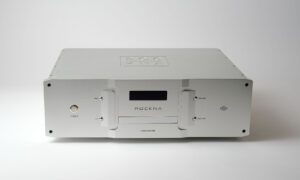
B.Audio B.DAC EX digital converter
The brothers Bermann – whose initial graces a small but aesthetically pleasing range of electronics – are keen to maintain aesthetic continuity in their creations. The B.dac shares its front panel design with the rest of B.audio’s product range and at a glance could be confused with almost any of them. I looked at the pre-and power amplifiers from their entry-level B.one range in Issue 187 and save for a few more dots around the controller the B.dpr one preamplifier looks exactly like this DAC. This commonality of design makes for more economical casework manufacture and it does look good; B.audio gear is nothing if not stylish.
The B.dac is the top converter in the company’s range and in EX guise it incorporates a streaming module that can be controlled with a range of third-party software including UPnP, Roon and MPD apps. It offers a good range of digital inputs including S/PDIF via wire or fibre, AES/EBU over XLR and USB, it also receives Airplay from your iOS devices. The EX version adds an RJ45 for ethernet connection (there’s no Wi-Fi receiver) and a USB slot for music stored on a suitable drive. Interestingly it has integrated cloud/UPnP server access, which means you can access your music from any location, maybe even the yacht. It plays PCM up to 32-bit/384kHz and DSD up to 256, so it’s not groundbreaking but more than adequately equipped in terms of file playback compatibility. B.audio do not list the formats it can handle but this side of things seems to be settled now and all decent DACs can convert pretty well to any sensible format.
Another unusual feature is DSP room correction which is designed to allow frequency response adjustments. These adjustments are made with the chunky if initially confusing remote handset with its seven unmarked buttons. I was able to access the settings but adjusting them requires a bit more explanation than is provided in the manual. Hopefully, B.audio’s dealers will be better informed.
The tech inside this DAC is clearly not off-the-peg stuff and includes a jitter removal process that the Bermann bros claim to be unique and is said to eliminate the timing errors that are inherent to digital signal transmission. Their approach is to combine phase lock loop and asynchronous resampling tech using a method that is claimed to avoid the limitations of both by incorporating their own clocking for all sources and sending that to the conversion stage alongside the signal. The B.dac also has upsampling filters using a custom-designed DSP engine with a linear phase filter, this is designed in-house and said to reduce pre-ringing whilst preserving the transient response.
The power supply side of any digital audio device is more critical than sometimes seems to be appreciated, albeit the growth in third-party supplies for low voltage devices would suggest that the message is getting through. B.audio use separate transformers for the digital and analogue sides of the circuit with regulators for each element within those circuits. No details of the DAC itself are included in the spec for this converter except for the fact that it’s a multibit sigma-delta type which suggests that it’s a conventional chip-based device rather than something concocted in-house.
My initial attempts at combining the B.dac EX with a Melco N10 music server and controlling the process with UPnP apps didn’t prove very successful, rather late in the day, I discovered the problem which was not with the DAC. In the meantime, Roon proved as flexible as ever and soon had the B.audio streaming music from my collection. Latterly, Sebastian Bermann suggested I try the UPnP approach with a USB drive plugged into the back of the unit, this also bore fruit with the DAC providing access to the music files via mConnect which showed the B.audio server among the options in its ‘play to’ list. The hot news is that B.audio plan to release their own UPnP control app in future, and while this will probably be a version of an existing piece of software, it might enable the adjustment of parameters within this DAC’s feature list in an easier way than via simple display. This only shows the text, and let’s face it, there is no need to have album artwork or other info on a streamer when this is available on the device in your hands.
Using the B.dac EX with Roon and streaming local media from the Melco N10 is a plush experience; you get a lot of refined energy and rock-solid timing from the very first notes. This much as apparent with Mike McDonald and Phoebe Snow’s rendition of ‘Knock on Wood’ [New York Rock And Soul Revue Live At The Beacon, Giant] as was the phenomenal quality of both voices from a concert which is something of a treat for fans of Steely Dan. Chesky made a great job of Macy Gray’s Stripped, in the B.audio’s capable hands the song ‘Annabelle’ has so much air and depth it really opens up the room. This piece also reveals the streamer/DAC to have very low noise, you don’t get so much fine detail with lesser converters, nor do you get such engaging music. This isn’t just technical refinement, it’s musically sophisticated too, or at least as slick as the music you choose to play. I put on an older recording by Bill Evans, ‘Waltz for Debby’ (Take 2) [Waltz for Debby, Riverside] and here there was more of the lively audience-filled room than usual behind the restrained, yet captivating rhythms produced by Scott LaFaro and Paul Motian, there is no doubting the live nature of the recording despite the relatively crude quality of the stereo recording.
Keith Jarrett’s solo performance recorded several decades later at Carnegie Hall [ECM] produces a rather more realistic picture of a piano on a stage; its full-bodied scale and tonal range make a distinct impression on the air in the listening room. His yodels and groans do nothing to undermine the effect that the piece produces. Bass is superb on the B.dac, as finely rendered and distinct as any other frequency range with a great nimbleness when required. It’s not the dry and slightly grainy bass you get with many D/A converters but the full, juicy, ripe low end that reflects the nature of whatever instrument it’s producing with ease.
I didn’t have a similarly priced DAC for comparison during the test period (such devices are lodged in my ear’s ‘muscle memory’) but what I did have made the B.audio sound totally effortless. And not in a limp, overly smoothed manner either, it has all the dynamics and speed you could desire thanks one suspects to the efforts that the company has put into dealing with jitter. It loves a good recording of course and Marcin Wasilewski’s En attendant [ECM] is just such a thing. The way that the musicians appear in front of your ears is almost magical, close your eyes and it really does transcend the barrier between listener and performers. I got very similar results using the USB input connected to the appropriate output on the Melco, you lose some of the transparency this way because streamers usually have an advantage over this approach but it’s pretty close. Spatially it remains extremely strong, Christian Scott’s ‘Angola, LA & The 13th Amendment’ [Yesterday You Said Tomorrow, Concord Jazz] has intensity and superb dimensionality, with the various instruments placed precisely in a soundstage that is alive with energy.
Moving over to UPnP operation with music stored on a USB thumb drive didn’t change things a great deal. It brought a little more openness perhaps but the difference between this and Roon/Melco wasn’t as great as it can be. Clearly what the DAC is doing has more of an influence than is generally the case. Patricia Barber’s ‘Subway Station #5’ [A Distortion of Love, Antilles] was very persuasive though, the way she combines attack, speed and subtlety of playing on this fast and dynamic track is inspiring. Steve Marriott’s voice manages to cut through the compression on ‘Afterglow’ [Small Faces, The Autumn Stone, Castle] and shine like a beacon on a stormy night and Laura Marling images like she’s in the room on her new Lump album Animal [Chrysalis], which is clearly a full envelope recording when played by the B.dac EX.
The Bermann brothers have done a fine job with this DAC and streamer; it may not have fashionable bells and whistles like MQA or Tidal Connect but it does have a strong feature set and can deliver sound quality that matches its price point and often exceeds it. Returns do diminish in high-end audio but it’s the small gains that make all the difference; in this case, delivering digital audio with the clarity and effortlessness of good analogue, and that is still very rare.
TECHNICAL SPECIFICATIONS
- Type: Solid-state high-resolution PCM, DXD and DSD‑capable digital-to-analogue converter/streamer
- Digital Inputs: One AES/EBU, two coaxial, two Toslink, and one USB type B
- Analogue Outputs: One stereo single-ended (via RCA jacks), one balanced (via XLR connectors)
- DAC Resolution/Supported Digital Formats: All PCM from 44.1KS/s to 384KS/s with word lengths up to 32-bit, DSD64 (2.8224MHz) up to DSD256 (11.2896MHz)
- Frequency Response: Not specified
- Distortion (THD + Noise): Not specified
- Output impedance: XLR – 100 Ohms, RCA – 75 Ohms
- User Interface: Roon, third-party UPnP apps
- Dimensions (H×W×D): 91 × 450 × 375mm
- Weight: 7.4kg
- Price: £12,000
Manufacturer: B Audio SAS
Tel: +33 3 89 73 01 41
URL: b-audio.com
By Jason Kennedy
More articles from this authorRead Next From Review
See all
Reiki Audio SuperSwitch Master Pro + Servant Pro
- Mar 27, 2024

Melco Audio N1-S38 music server
- Mar 27, 2024

Focal Utopia 2022 headphones
- Mar 27, 2024











